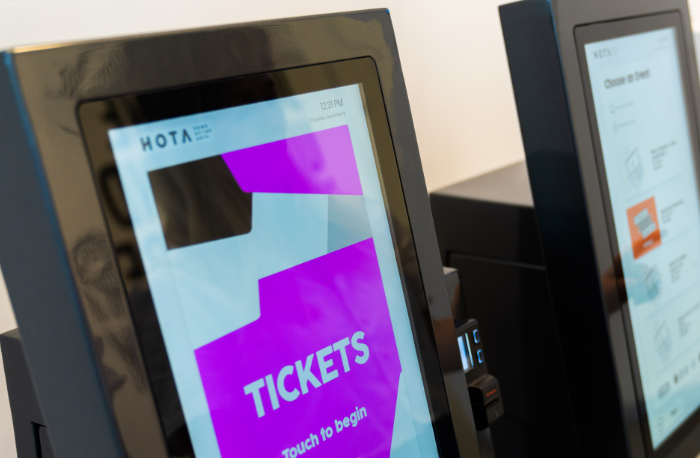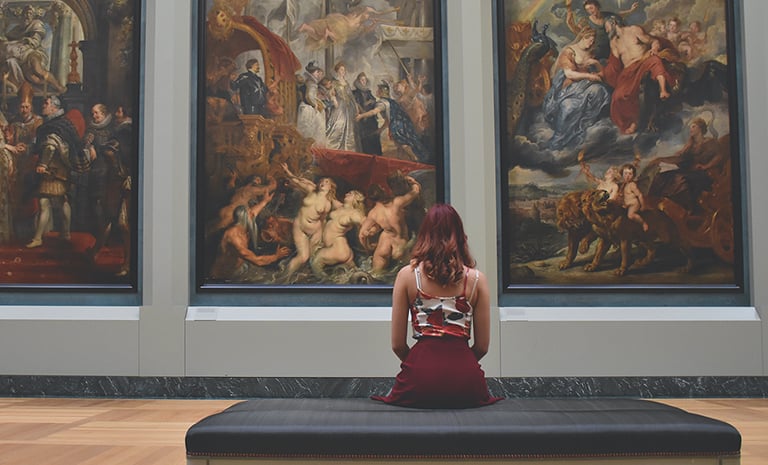Arts and Culture
Ticketing and Admissions
Article
Success Stories
06fd53d4-5fff-4291-b851-a09a1b4f141a
5 min
https://edge.sitecorecloud.io/tessituraneab9a-tessiturane5642-staging-5396/media/Images/Success-Stories/HOTA---768x465.png?h=465&iar=0&w=768
How HOTA created a human-to-human customer experience with Tessitura-integrated kiosks
Technology brings bold vision to life at award-winning Australian arts centre
1/11/2023
5 min
“It was clear that the ecosystem we could build with Tessitura

was going to fulfil our needs to be data-focused and driven,” said Grant Brisland. Grant is Director, Business Growth & Development at HOTA, Home of the Arts in Gold Coast, Australia. “Within 12 months we were seeing the benefits of having better reporting and dashboards.”
HOTA had an imaginative vision for visitor experience at its new gallery. It came to life with the right technology and collaborative partnerships. Implementing Tessitura-integrated kiosks had powerful outcomes for the premier arts centre. These include a streamlined visitor experience and increased conversion to ticket sales. They have also seen centralised data collection and increased staff productivity.
HOTA had an imaginative vision for visitor experience at its new gallery. It came to life with the right technology and collaborative partnerships.
We spoke to Grant and HOTA’s Ticketing Manager Pryce Pincott. We asked them about the challenges they faced as they planned for HOTA Gallery's opening. They shared how they rethought the traditional box office model to create a better customer experience.
Unique architectural challenge
Grant faced some unique challenges when he arrived at HOTA in February 2020. The new HOTA Gallery was under construction and due to open in just over 12 months. “I needed to create a 21st-century ticketing experience. I had the added challenge of a global pandemic and a construction project on a critical time path. And I was new to the organisation”, he said.
On top of that, they had architectural puzzles to solve. The gallery under construction was a six-storey building. It would have five separate entry points into the foyer. Grant assessed how ticket sales, ticket collection and information dissemination would function. Visitor flow was a primary concern, particularly for future blockbuster events. It became clear that a conventional ticket or reception desk wasn’t going to work.
During the development phase, the project team looked at venues around the world. Some stood out as having particularly strong person-to-person interactions between customers and staff. These examples felt contemporary and personal — and they reflected the HOTA value of citizenship.
Rethinking the model
The team decided that a traditional box office model would not fit their needs. Their visitor services team would integrate into the guest environment to enable more organic interaction. Visitors would not have to queue at a single point of sale or information. Members of the team would use their instincts, with the help of technology, to assist customers as needed.
How to accomplish this? Kiosks would provide multiple places for visitors to purchase tickets on site and they could be placed throughout the building, including at access points to paid exhibitions.

This model would overcome the constraints of the architecture. People would have a positive experience as they entered and navigated the gallery. HOTA called this concierge-style experience “eyes up”. This phrase refers not just to the interactions between staff and visitors, but also to how visitors would engage with the art.
“We wanted our staff to be more focused on deeper engagement with visitors. We want interactions that go beyond the monotony of transactions.”
“We would train our team to engage in deeper conversation about works,” Grant explained. “At its very core, arts and culture is about connecting communities. and we wanted our staff to be more focused on deeper engagement with visitors. We want interactions that go beyond the monotony of transactions. Our staff would make conversation and share insights but the visitor could still have their own interpretation.”
From vision to reality
But finding a kiosk solution was not as straightforward as the HOTA team hoped. After exploring many options, they discovered their existing ticketing and CRM system would not easily integrate with kiosks.
It was less than a year out from the Gallery opening and six months after Grant had joined HOTA. Needing a way to implement their vision, they had no choice but to go to market.
New technology and partnerships
HOTA chose Tessitura for its CRM platform, following a successful tender process. The selection panel included representation from ticketing, visitor services, marketing, membership, fundraising and executive leadership. Each member of the panel rated Tessitura as the frontrunner, demonstrating cross-departmental support for this solution.
The HOTA team also appreciated that Tessitura is a not-for-profit organisation owned by the arts and cultural institutions who use its technology. “The Tessitura community and the membership operating model were big wins for us. The arts, culture and attraction focus was also important. We weren’t going to be playing second fiddle to big sporting arenas and clubs,” Grant added.
“The Tessitura community and the membership operating model were big wins for us. The arts, culture and attraction focus was also important.”
Tessitura has integrations with several of HOTA’s existing partners. It also has a partnership with integrated kiosk provider KIS Technologies. From early conversations it was clear that KIS understood HOTA's vision — and the urgency of the situation. "KIS understood our needs," explained Grant. "The initial conversations with their team inspired our confidence in their abilities."
During the implementation, “the constant communication with Tessitura and KIS was great,” said Pryce Pincott. In a matter of months, they deployed Tessitura and the kiosk systems to fulfil HOTA's vision.

Positive outcomes
The Gallery opened to the public on the target date of Saturday 8 May, 2021. In the first 10 days more than 165,000 people came through the doors. Visitors immediately began using the kiosks to purchase tickets to the opening exhibition.
Since their successful opening, Grant and Pryce have seen several positive outcomes, including a few that they hadn’t expected.
1. Streamlined visitor experience
The kiosks give visitors control of their experience. They don’t have to stand in a long line to buy event tickets. The straightforward, user-friendly interface ensures visitors don't need much guidance or support. "The kiosks enable a pick-your-own-adventure. This has been a critical part of the audience journey and audience flow,” Grant explained.
“It is fantastic to have the infrastructure in place with Tessitura and KIS. The kiosks can handle a constant influx of transactions. They also provide a seamless ticketing experience."
2. Better data collection
HOTA offers many free experiences. Until now, attendance for these events remained unregistered. They did not have a complete understanding of their audiences. The kiosks enable the organisation to ticket free experiences and capture vital first-party data. Email addresses enable them to build relationships with these visitors. Postcodes are useful for reporting to stakeholders. HOTA can now track which experiences are the most popular and when people are most likely to attend.
3. Last-minute ticket sales
The kiosks are able to handle last-minute day-of sales. Up to 80% of ticket sales for HOTA Gallery exhibitions can happen on the day of an event. For some events, this has reached 90% on a single day. Of those, most purchases have been at the kiosks. The interactive exhibition Bricktionary took place during April to August of 2022. 63% of tickets sold on the day, with 62% of those through the kiosk. For Lyrical Landscapes in July to October, 64% of tickets sold on the day, with 78% of these through the kiosks.
“No organisation loves late bookings. But it is fantastic to have the infrastructure in place with Tessitura and KIS. The kiosks can handle a constant influx of transactions. They also provide a seamless ticketing experience. It’s vital that this is an easy, fast and welcoming experience,” Pryce said.
4. Increased staff productivity
The kiosks have freed up staff to provide better customer experience. Adding kiosks didn't reduce the need for staff; it relocated them to higher-value tasks. They can now spend more time interacting with, and supporting, the customer.
Until now, ticketing and selling responsibility sat with the box office team. Now, any staff member with a front-facing role can support customers.
“Implementing Tessitura and the wider ecosystem has elevated our understanding of our audiences. We can now take a customer-centric, data-driven approach.”
On the horizon
HOTA plans to replicate this visitor services model at the HOTA Central building. They also plan to begin selling memberships via the kiosks.
“Implementing Tessitura and the wider ecosystem has elevated our understanding of our audiences. We can now take a customer-centric, data-driven approach. The integration with the KIS team has exceeded all expectations; they’re committed to developing their software and deliver every time,” Grant said.
Topics
Arts & Culture
/Ticketing & Admissions

Propelling innovation
Arts & Culture / BI & Analytics / Business Strategy / Digital / Technology
Three technology advances driving digital transformation in arts and culture

Debunking four digital transformation myths
Arts & Culture / BI & Analytics / Business Strategy / Digital / Technology
Setting the record straight about common misconceptions
